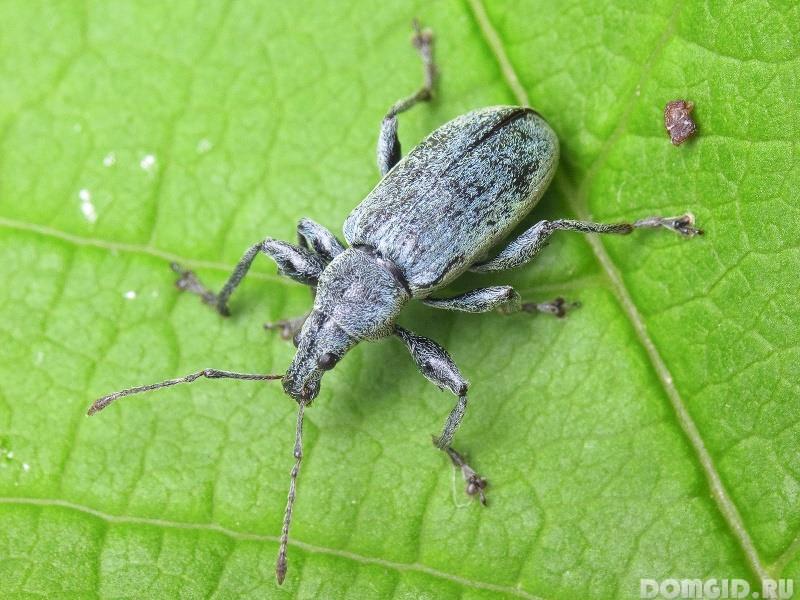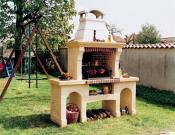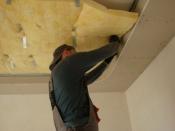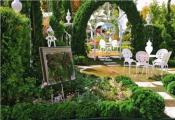Search
Login
Strawberry on a personal plot, reproduction, care
You can grow strawberries on a personal plot on any type of soil. There is, of course, a correlation between the type of soil and the quantity and quality of the harvested crop. Both experienced agronomists and amateur gardeners unanimously argue that the best strawberry crop can be grown on podzolized chernozems and forest dark gray soils. Light gray, soddy, peat soils will not yield the best yield in quality, while the number of berries will be catastrophically small. Ideal for planting strawberries will be the chernozem in which groundwater is no deeper than 60 - 70 cm from the surface. Also, for strawberry cultivation, a plot with a slope of 2 - 4 degrees to the south-west side is suitable. It is in this place that the plant vegetation occurs earlier, therefore the ripening of the berries is much faster. Strawberries will feel very bad in areas located in the lowlands, exactly where there is no air movement.
Content
- Planting strawberries video
- Strawberry Mustache
- Strawberry propagation
- Strawberry dressing video
- Strawberry Diseases and Pests video
Planting strawberries

Having set the goal to get a rich harvest in quality and quantity, you need to use seedlings that have been healed and sorted in advance. In such seedlings, the root stem in diameter will be at least 6 mm, the root itself will have a fibrous appearance, and the processes of the root system will reach a length of 7 -9 cm.The most preferred strawberry varieties for planting are elite, primary reproductive and frigo plants. The latter, by themselves, means plants extracted from the earth in the last days of autumn and stored throughout the winter under conditions that provide low, but not minus temperatures.

Planting strawberry seedlings can be made both in early autumn and early spring. It is very important for plants not to miss the agreed planting dates and to do it as soon as the weather conditions accompany this. If the deadlines are missed, especially in the spring, then most likely, the bulk of the seedlings will not take root. In the autumn period, the best time for strawberries to take root is the period from August 10 to September 25. A prerequisite for autumn planting is well-moistened soil. How exactly hydration will occur: naturally - heavy rain or organized watering, there is not much difference.

Immediately before planting in open ground, strawberry seedlings are stored in an unheated room for about 5 days. When preparing the soil for planting, it is necessary to water it, but not to fill it with large amounts of water. It is here that you need to remember that everything should be in moderation. Tara with seedlings, during field work, must be put in the shade. In order to determine whether the planting of seedlings is done correctly, just look at the work done. Visually, the basal part of the stem above ground should be visible. In cases where the root shoots grow more than 10 cm - they are shortened.

After the planting is done, the plants must be watered. To prevent contraction of the soil surface in the wells, the soil is mulched, do it immediately after watering.
During the growth of seedlings, flowering strawberries and fruiting, weeds must be removed from the aisles.

Experts advise: to clean the selected area for planting strawberries in advance from harmful insects and pathogens. In the future, such actions will save you from problems with the growth and quality of the crop.
Strawberry Mustache
As practice shows, young strawberries, growing the first year, give the largest number of mustaches. Moreover, the quality of the shoots is also the best only in one-year-old plants. Such a pattern is inherent in these plants at a biological level.
But precisely in the first year of plant life, gardeners do not have a special need for a mustache. In the following annual cycles, plants of this family form more and more flowering buds and, accordingly, less and less mustache. It is during this period of time that there is an acute need for a mustache.

To solve this problem, there is one proven method: separation of plants into mother liquors and berry plants. With the arrival of summer on the bushes with ovary, the mustache is removed. So they will not interfere with the flowering and formation of berries. Thus, the possibility of the full formation of the berry and the possibility of the full development of separated outlets appears. Indeed, in the middle of May, the rosette reaches its peak of fullness with elements useful for growth and those necessary sizes that will allow it to take root and grow further as an independent plant. Over the entire summer period, the planted mustache will have time to form before full bushes and begin to bear fruit already with the arrival of next spring. The mustache, separated in mid-July - early August, will not have time to take shape as independent plants until mid-autumn. Therefore, during this time period it is not advisable to deal with strawberry planting with the help of a mustache.
Strawberry propagation
With the decision to plant strawberries in a separate way, you need to do the following:
- determine the most suitable place on the site (well-lit area, unhindered exposure to sunlight, well-fertilized land, lack of weeds, and so on);
- plant plants;
- when the whiskers first appear, remove them, giving them the opportunity to develop flowering buds and activate fruiting.
Being in such conditions, the berry plants will please with their active growth and give a good harvest.
With mother liquors, the situation is not much different. Choosing a place, you need to choose a plot of land with partial shade formed for example by a fruit tree. The soil here should be: as fertilized as possible, constantly watered and loosened. In such prepared soil, with the advent of spring, you can plant plants. Around the beginning of June, when the peduncles and mustache appeared, the peduncles were removed. Thus, by the end of summer, in this area they will be ready to transplant into a berry and annual plants and a mustache formed in the bushes.

In late autumn, strawberries must be covered. Often, shelter produce all sorts of rubbish. There will not be much sense from this. The best material for this is fallen foliage. Leaves, unlike trash (film, cardboard, rags, and so on), will more reliably protect the seedlings from the effects of frost, a sharp temperature drop due to the thaw (they will not allow strawberries to be blocked).
Leaves for shelter is better to collect in dry weather. Another important point in the collection - to capture a couple of centimeters of turf located under the fallen leaves. Later it will serve as an excellent fertilizer. By the way, you can use it not only for fertilizing strawberries.
Strawberry dressing
Feeding is carried out throughout the entire growing season. The best remedy for this is organic fertilizer or manure. Feeding is a serious matter, therefore, it must be done correctly and on time. In this matter, special attention should be paid to seedlings growing in the first year. In principle, feeding strawberries at any age should be done with a solution prepared strictly with the recommended instructions.

To feed a year-old strawberry, you need a mullein. Dilute it 1 cup in 5 liters of water. Each seedling should have at least 1 liter of solution. Just before a strawberry begins to bloom, it will also need strength. During this period, a solution of nitrophosphate diluted in proportion: 2 tablespoons of nitrophosphate, 1 teaspoon of potassium sulfate per 10 liters of standing water will be relevant. Experts advise to pour at least 0.5 liters under each bush.
Since the main part of top dressing falls in the spring, it can be produced, for example, during transplantation or immediately before foliage blooming. When feeding with humus or chicken droppings, you should be as careful as possible, because excessive zeal and zeal can harm the future crop.
The last top dressing is done in mid-September in dry weather. It is especially significant for year-old plants.
Recently, summer residents began to use yeast as a top dressing. Reviews about this method are only positive. In addition to feeding strawberry yeast, they can also be used to stimulate other fruit crops.

Yeast composition is added strawberries 2 times per season. The composition is diluted as follows: 1 kg of yeast is diluted in 5 liters of water. After the yeast dissolves, 0.5 liters of top dressing is diluted with 10 liters of water. Under each bush, it will be enough to pour 0.5 liters of the mixture.
Strawberry Diseases and Pests
The most common strawberry disease is late blight. This disease can be recognized by the red-pink color of the axial cylinder. This disease can be both chronic and transient.

The chronic form of the disease gives itself out to be the delayed development of a single seedling, a special cupped form of deciduous formation and a non-naturally prevailing gray color on the leaves. Berry picking on such bushes is significantly reduced, and often disappears altogether. The complete death of such a bush occurs after a few years from the moment the infection occurred.

The transient form of the disease is the rapid death of foliage located close to the ground. In more rare cases, only flower stalks die. At this time, irreparable changes occur in the root system, namely, the fibrous part dies. The central root stalk becomes reddish. This will be especially visible if you cut it longitudinally.
In order to avoid such and similar painful injuries on plants, you need:
- clearly comply with agricultural regulations,
- do not plant strawberries on the same territory for more than 4 years in a row,
- maximally control the material for planting (do not use damaged, diseased or infected stems as seedlings),
- before planting, do not forget to dip the roots of the bushes in a mixture of drugs (humate and agate),
- if pathogenic formations are found, eliminate the plant.
Still on this occasion, experts give good advice - in cases where all the requirements are clearly followed, and the plants still do not stop getting sick, you need to switch to breeding more resistant varieties.
In nature, there are a large number of insects that can cause significant harm to both strawberry bushes and its fruits. The greatest problem for the normal development of fruit crops can cause transparent tick.

First of all, it harms young, just beginning to blossom, foliage. Work on the prevention and control of it must be done before the beginning of the flowering period and after the last berries are picked. The last spray should be done before mid-August.
No less threat to the plants are weevils. They have a black and gray color, grow up to 3 mm in length. Winter is spent in the topsoil or in a layer of fallen leaves.

With the advent of spring, when the air temperature warms up to 13 C and the plant begins the growing season, the beetles crawl out of their shelters and actively begin to eat young foliage. The younger the leaf, the more likely it is to be eaten completely. During the formation of buds, female weevils produce eggs in them. After a certain period of time, larvae appear from the buds - small white worms with yellow heads.
Young growth destroys both foliage and buds. When the plant practically stops the fruiting process, the larvae turn into beetles. For some time they will eat up the remaining berries and leaves, and then crawl into the ground for wintering.
The fight against them is carried out at a time when the buds are just beginning to appear or immediately after the collection of berries. Plants are sprayed with a solution of malathion emulsion, diluting it in a percentage of 30 g per 10 liters of water. In the autumn, it is better to destroy the remains of plants, and to loosen the soil well.





